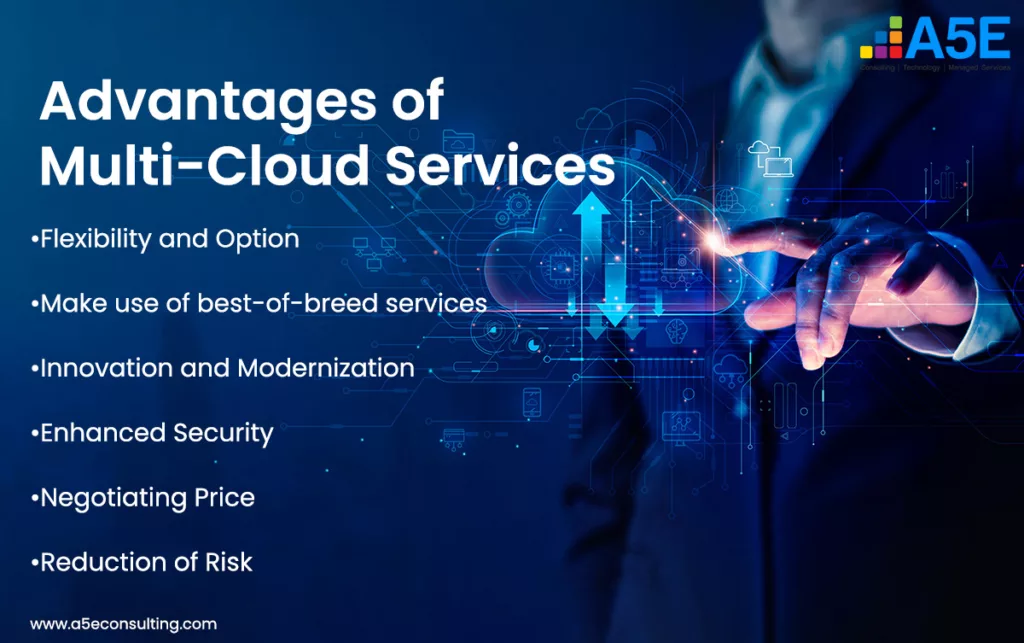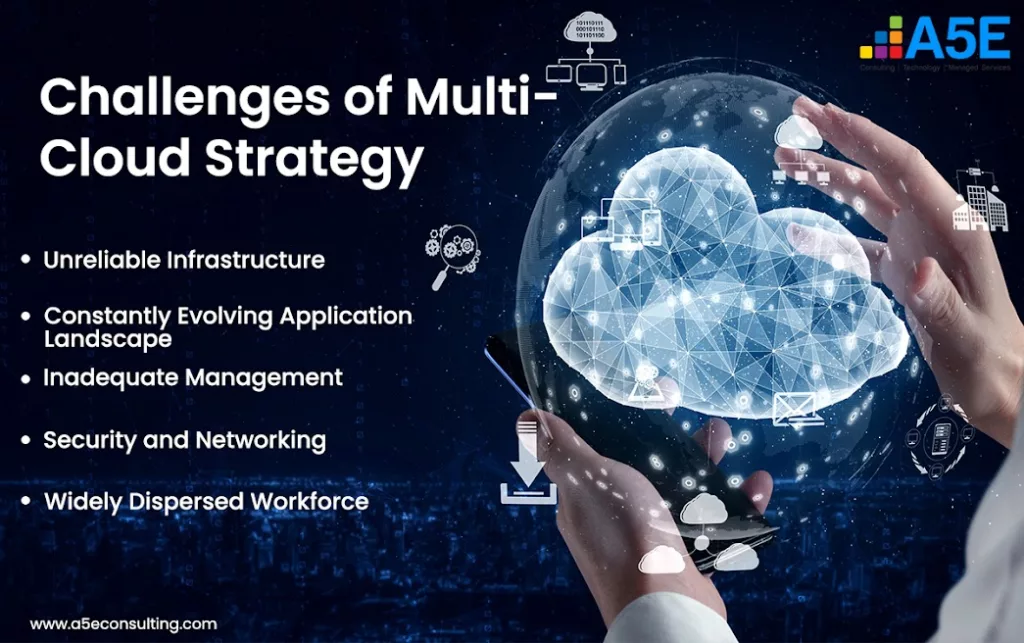
Multi Cloud Strategy: Multi Cloud Advantages
What Exactly is MultiCloud?
A multi-cloud strategy is the deliberate use of cloud services from multiple cloud providers to achieve business objectives. It involves selecting and integrating the best-of-breed services from different cloud providers to create a hybrid cloud environment that meets the specific needs of an organization.
MultiCloud Platform is a concept that involves utilizing a variety of cloud resources, including public clouds, private clouds, and edge computing, to build, operate, and secure applications consistently across different platforms. Enterprises adopt multi-cloud strategies to deploy applications on the cloud that best suit their needs, modernize their applications, ensure enterprise sovereignty, and secure their workforce. Multi-cloud infrastructure provides the flexibility to run workloads on any cloud and manage and secure applications consistently across different clouds. With a successful multi-cloud approach, businesses can increase their agility, reduce costs, and minimize risks across their IT landscape.
Multicloud solutions address enterprise sovereignty concerns by providing greater data and application control. Multiple cloud service providers prevent vendor lock-in and allow businesses to choose regulatory and compliance-aligned platforms. Robust identity and access management capabilities enhance workforce security, safeguarding sensitive data and preventing unauthorized access.
Use Cases of MultiCloud
To accelerate their digital transformation journey, enterprises are leveraging a B2B multicloud platform with multiple cloud platforms and services for various reasons:
- To accelerate app transformation and the delivery of new apps: Instead of a cloud-first approach, businesses are opting for a smarter strategy, deploying apps on public, private, and edge clouds that align with their business needs and goals.
- To avoid vendor lock-in and ensure data sovereignty: Organizations are spreading their cloud estate across multiple environments to manage cloud spend, vendor dependencies, and lock-ins while avoiding vendor lock-in and ensuring data sovereignty.
- To distribute applications and services to the edge: Businesses in logistics, retail, and manufacturing are distributing applications and services to the edge to achieve greater automation, efficiency, and improved customer experiences.
To support the rise of the distributed workforce : Securing and managing user devices, and enabling remote productivity is becoming a priority for enterprises in managing their distributed workforce.
Advantages of MultiCloud Services
Organizations can gain many multicloud benefits from leveraging these services to abstract core services offered by cloud providers. These benefits include:

- Flexibility and Option: Entailing the adoption of multi-cloud services, businesses can harness increased agility and flexibility to maintain a competitive edge in their respective markets. By strategically utilizing multi-cloud solutions, they can embark on a systematic modernization of their application portfolio, seamlessly migrating workloads and resolving the constraints imposed by legacy infrastructure and limited in-house expertise. This empowers them to effectively manage their entire application landscape and select the most suitable cloud-specific services for each application, maximizing the potential of the multi-cloud approach.
- Make use of best-of-breed services: Enterprises can leverage a multi-cloud solution strategy to select the best cloud platform that offers the most optimal technology solution at a competitive price. Organizations can evaluate the physical location, database, pricing, service level agreement, and performance characteristics of each provider to create a comprehensive cloud solution tailored to meet their specific business needs.
- Innovation and Modernization: By utilizing modern orchestration tools, organizations can automate the management of a multi-cloud strategy, which includes managing cloud and on-premises workloads. This automation can allow IT resources to be utilized for code modernization and innovation, allowing the organization to take advantage of the latest services, products, and platforms that are continuously being introduced.
- Enhanced Security: When adopting multi-cloud services, organizations often embrace a zero-trust approach to cloud security that can guarantee the security of every transaction and interaction taking place in the cloud. While every major cloud provider provides advanced physical security, logical security is still the organization’s responsibility when using cloud providers for their IaaS platforms.
- Negotiating Price: Organizations can gain an advantage in pricing by using multiple cloud providers. The competitive market pressure on providers to deliver Infrastructure as a Service (IaaS) to savvy customers increases the bargaining power of organizations. This allows them to compare different providers and secure the best possible pricing and payment terms for each contract.
Reduction of Risk: By adopting a multi-cloud approach, organizations can mitigate the risk of infrastructure failures or cyber attacks. They can quickly switch workloads from one cloud provider to another and then return them when the issue has been resolved.
How is Digital Transformation Enabled by a MultiCloud Strategy?
A multi-cloud strategy can enable digital transformation by providing businesses with the flexibility, scalability, and agility they need to adapt to the ever-changing demands of the digital marketplace. By leveraging multiple cloud providers, businesses can choose the best cloud services for their specific needs and avoid vendor lock-in. This can help them to accelerate innovation, improve customer experience, and reduce costs. Here are some specific ways in which a multi-cloud strategy can enable digital transformation:
1. Accelerate innovation : A multi-cloud strategy can help businesses accelerate innovation by giving them access to a wider range of cloud services and technologies. This can help them to experiment with new ideas and develop new products and services more quickly.
2. Improve customer experience : A multi-cloud strategy can help businesses improve customer experience by providing them with the ability to deliver more personalized and responsive experiences. This can be done by using cloud services to collect and analyze customer data, and then use that data to personalize customer interactions.
3. Reduce costs : A multi-cloud strategy can help businesses reduce costs by allowing them to shop around for the best cloud services for their needs. This can help them to avoid overspending on cloud services.
4. Increase agility : A multi-cloud strategy can help businesses increase agility by allowing them to quickly and easily scale their IT infrastructure up or down as needed. This can help them to respond to changes in demand and take advantage of new opportunities.
5. Improve security : A multi-cloud strategy can help businesses improve security by providing them with the ability to spread their data and applications across multiple cloud providers. This can make it more difficult for attackers to target their data and applications.
6. Enhance compliance : A multi-cloud strategy can help businesses enhance compliance by providing them with the ability to choose cloud services that meet their specific compliance requirements. This can help them to avoid fines and other penalties.
7. Foster innovation : A multi-cloud strategy can help businesses foster innovation by providing them with access to the latest cloud technologies. This can help them to experiment with new ideas and develop new products and services more quickly.
8. Optimize costs : A multi-cloud strategy can help businesses optimize costs by choosing the most cost-effective cloud services for their needs. This can help them to avoid overspending on cloud services.
9. Improve performance : A multi-cloud strategy can help businesses improve the performance of their applications by using the cloud services that offer the best performance for their needs.
10. Increase customer satisfaction : A multi-cloud strategy can help businesses increase customer satisfaction by providing a more reliable and consistent experience.
Overall, a multi-cloud strategy can be a valuable tool for businesses that are looking to digitally transform their operations. It can help them to be more agile, innovative, and cost-effective, and it can also help them to improve customer experience and comply with industry regulations.
Challenges of MultiCloud Strategy
The adoption of multi-cloud services presents a challenge for IT organizations in supporting various application architectures and workloads across different cloud platforms. Each provider offers unique capabilities that are not shared with other platforms, resulting in inconsistencies in infrastructure and operating models. This adds complexity and risk to the environment, causing pain points for both IT personnel and developers in successfully operationalizing multi-cloud, especially in the context of cloud application development:
Some of the multi cloud challenges are-

- Unreliable Infrastructure: The lack of a consistent multi-cloud infrastructure across all environments forces cloud operational teams to work in isolated units, with limited flexibility to adapt to changing business requirements.
- A Constantly Evolving Application Landscape: To keep up with the pace of digital business, organizations must accommodate the increasing intricacies of application architectures, both old and new, while maintaining performance and availability across multiple cloud environments, and supporting DevSecOps.
- Inadequate Management: The absence of a streamlined and uniform infrastructure and management tools for multi-cloud in different cloud environments can lead to higher expenses and create significant security vulnerabilities.
- Security and Networking: The process of securing and networking applications and data across multiple cloud platforms is complicated, leading to potential security vulnerabilities, higher risks, and a larger surface area for potential attacks.
A Widely Dispersed Workforce: As enterprises expand their reach to include more external data and users, they find it challenging to balance the need for choice, flexibility, and a user-friendly experience while maintaining a high level of security.
A5E Consulting: Embracing the Power of Multicloud Services
A5E Consulting is a renowned provider of multicloud services, offering a comprehensive suite of technologies meticulously designed to seamlessly integrate with multi-cloud environments. By optimizing their business operations across diverse functions, organizations can achieve a transformative shift in their digital journey. Our tailored solutions are specifically curated to help clients fulfill their strategic objectives and accelerate their digital transformation initiatives.

Related Posts
Post a Comment cancel reply
You must be logged in to post a comment.




